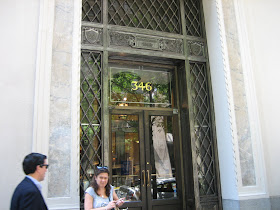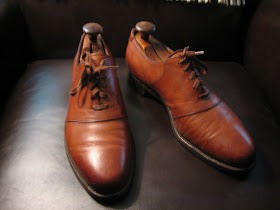When last we walked the streets of midtown Manhattan together, we stopped by the Crockett & Jones shop just off Fifth Avenue. In this edition of The Walking Tour, we'll continue south along Fifth Avenue to Saks before heading back to Madison Avenue to check out Paul Stuart and the Brooks Brothers' Flagship Store at 346 Madison Avenue.
Saks & Co., located on Fifth Avenue and taking the whole east side of the street from 49th to 50th street (611 Fifth Avenue), has an eclectic inventory of shoes on display at the 6th floor shoe department. From classic business-conservative English shoes to the sleeker, more fashionable styles from France or Italy, Saks has something for everyone, be it Church's and Edward Green or Kiton and Artioli.
When I dropped by the shoe department, there was a pre-sale event in progress. Selected models were at 30% off.
The discounted models also included three pairs of gorgeous Kiton dress shoes - I forget the actual retail and discount prices, but I believe the shoes were still well north of $1000 after the discount. The Kitons were impressive to behold in person, and did not have the "dainty" look that I generally associate with Italian-made shoes.
Kiton shoes: The three shoes at the top with shoe trees -
a brown captoe with adelaide throat, black blucher captoe, and black wingtip.
The Artioli Display
The Church's Display
If you get tired of looking at all of the shoes on display, walk across the length of the floor to the other end of escalators. Here you'll find shirts and ties from various makers - I'll leave that for another day. To hold you over, here's the Charvet display - looking at the vibrant palette of colors, it's easy to see what Jean Cocteau meant when he said that Charvet is "where the rainbow finds ideas."
Time certainly flies at Saks, so whenever you happen to be done, exit the building and walk east towards Madison Avenue. Once on Madison, walk south about five blocks to Paul Stuart at 45th Street.
Before you walk through the double doors, take some time to peruse the window displays. They are really quite impressive (please excuse my non-professional camera and generally poor photography skills):
I've been pleasantly surprised by the shoe selection at Paul Stuart lately. Unbeknownst to many, the store has quietly put together a fairly impressive collection of English shoes for sale. At the high end of the spectrum, the limited edition shoes from Gaziano & Girling are beautiful to behold although there are only a few models available (boot, wingtip, elastic-sided slip-on) at $1148 per pair. While I have always found the G&Gs to be almost too sleek, if such a thing is possible, the leather colors on display were simply stunning (vintage rioja, antique chestnut (?)).
Paul Stuart also offers a wide selection of models from Crockett & Jones and the Grenson Masterpiece line. I took a closer look at a few pairs of the C&Js and they all seemed to be on the 248 last. The Grensons are similarly high quality, and these shoes cost around $678.
Finally, there is a lower Italian-made line that, if I recall correctly, cost about $368. These models could also be called "business conservative" wear, although they appeared to be a bit sleeker with a daintier, thinner sole than the English-made models.
Once you've looked through the various shelves of shoes, don't forget to look at the sale display to the far right of the main group of shelves - I believe most shoes on the discount rack were priced at 50% off - and it appeared to be a permanent fixture in the shop.
I spent some time chatting with a sales rep in the shoe department during my visit. In addition to pointing out that the G&Gs will probably never go on sale in my lifetime (he chuckled as he said it), he also informed me that factory refurbishing was available for any of Paul Stuart's models for $170. That seems like a great price for refurbishing if the shoes are actually being worked on at G&G, C&J, or Grenson. This probably bears some looking into . . .
Once you're done at Paul Stuart, walk one block south along Madison to 44th Street and Brooks Brothers flagship store at 346 Madison Avenue. Brooks Brothers has what I'd call a very steady inventory of shoes for sale. The makers really haven't changed in quite some time, so you know what kind of quality to expect from the shoes when you walk through the door.
Come in through the Madison Avenue entrance and head directly for the escalator. Just to the right of the escalator on the ground floor, you'll see a section devoted to sleepwear, robes, socks, etc. Just beyond that, you'll see a little nook with a sign above the entrance stating "Shoe Department."
Brooks Bros. sells English-made shoes under their Peal & Co. line - essentially, Peal is a defunct English company that was resuscitated by Brooks Bros. for whatever reason. The Peal line shoes are actually manufactured in Northampton by Crockett & Jones and Alfred Sargent. The cognoscenti often talk about deciphering who made what shoe by looking at the nail pattern on the heel of the shoe. Generally, the C&Js will have one row of nails on the heel while the Sargents will have a double row on the heel. I've found that this is correct, although its fairly easy to identify the C&J models since the company includes handwritten last information inside each pair of shoes - so if you know that the 318, the 324, and the 248 are C&J lasts, you'll know that you're looking at a pair of C&Js. Regardless, both companies make very good shoes, and they retail for about $450-500 at Brooks Brothers.
In addition to the Peal & Co. line, Brooks Bros. also offers a line of shoes that are made in the USA by the Alden Shoe Company of Massachusetts. Known for their shell cordovan offerings in leathers such as Whiskey, Cigar, and Ravello, in addition to more basic colors like Black and Burgundy, Alden is probably the last great American shoe-maker so it is probably fitting that the company's shoes are available for purchase at one of America's oldest clothing stores.
Various Alden cordovan leather offerings on display at
Brooks Brothers' flagship store at 346 Madison Avenue.























































